Chapter 13-34. Sign Regulations
Prior legislation: Ord. 423.
Sec. 13-34.100 Purpose and Applicability.
The purpose of this Chapter is to:
1. Provide for the orderly construction, location, placement, size and maintenance of signs, outdoor advertising structures, and displays of any character, and to safeguard the general public from the hazards caused by dangerously and improperly located and maintained signs.
2. Promote and protect the public health, safety and welfare by regulating outdoor signs of all types. The specific goals are to protect property values, enhance and protect the physical appearance of the community, to reduce sign or advertising distractions and obstructions, and to ensure that new signs are compatible in design and scale with their surroundings.
3. Administrative Interpretations. All interpretations of this Chapter are to be exercised in light of the message neutrality and message substitution policies. Where a particular type of sign is proposed, and the type is neither expressly allowed nor prohibited by this Chapter, or whenever a sign does not qualify as a “structure” as defined in the Building Code as adopted by the City of Hercules, then the Planning Commission or Director, as applicable, shall approve, conditionally approve, or disapprove the application based on the most similar sign type, using physical and structural similarity, that is expressly regulated by this Chapter.
4. Message Neutrality. It is the City’s policy and intent to regulate signs in a manner consistent with the U.S. and California constitutions, which are content neutral as to noncommercial speech and do not favor commercial speech over noncommercial speech.
5. Message Substitution. Subject to the property owner’s consent, a noncommercial message of any category or content may be substituted, in whole or in part, for any allowed commercial message or any noncommercial message; provided, that the sign structure or mounting device is legal, without consideration of message content. Such substitution of message may be made without additional approval or permitting. The purpose of this provision is to prevent favoring commercial speech over noncommercial speech, or favoring any particular noncommercial message over any other noncommercial message. Message substitution is a continuing right which may be exercised any number of times. This provision does not:
A. Create a right to increase the total amount of sign area on site.
B. Create a right to substitute an off-site commercial message in place of an on-site commercial message or in place of a noncommercial message.
C. Affect the requirement that a sign structure or mounting device must be properly permitted.
D. Authorize changing the physical method of image presentation (such as digital, LED, or neon) display without a permit.
Except as otherwise provided in this Chapter, it is unlawful for any person to construct, erect, enlarge, alter, or relocate within the City any sign as defined in this Chapter, without first obtaining a sign permit for a sign or planned sign program, subject to design review approval, and a building permit. [Ord. 527 § 1, 2020; Ord. 515 § 2, 2018; Ord. 510 § 2, 2018; ZO § 34.100.]
Sec. 13-34.101 General Provisions.
[Ord. 527 § 1, 2020; Ord. 515 § 2, 2018; Ord. 510 § 2, 2018; ZO § 34.101.]
Sec. 13-34.102 Director Approval Required.
The Director of Community Development is authorized to approve, conditionally approve, or deny sign permits and sign programs, except where Planning Commission action is required, or when a referral to the Planning Commission is made in accordance with applicable sections of the Zoning Ordinance. Any application for a sign permit or sign program approval requiring action by the Director shall be acted upon within 30 days of submittal. [Ord. 527 § 1, 2020; Ord. 515 § 2, 2018; Ord. 510 § 2, 2018; ZO § 34.102.]
Sec. 13-34.103 Planning Commission Approval Required.
The Planning Commission shall hold a public hearing as specified in the Zoning Ordinance, review the application based on the criteria of this Chapter, and take action under the following circumstances:
1. The sign(s) does not conform to an established design policy adopted by the Planning Commission and/or City Council in accordance with this Section.
2. The sign is a freeway-oriented, freestanding pylon sign.
3. The approval of master sign programs or sign variances. [Ord. 527 § 1, 2020; Ord. 515 § 2, 2018; Ord. 510 § 2, 2018; ZO § 34.103.]
Sec. 13-34.200 Legal Conforming Signs.
Any sign that legally exists as of the effective date of the ordinance codified in this Section shall be considered a legal conforming sign.
1. Any legal conforming sign may be altered; provided, that sign has the same fixtures, similar materials, similar colors, and similarly styled lettering and provided the sign face is not enlarged as determined by the Community Development Director.
2. New signage may be proposed for a site that contains legal conforming signage; provided, that all new signage is in compliance with this Chapter. The Planning Commission may approve waivers to signage for a site that contains legal conforming signage, if such waivers are consistent with this Chapter. Such waivers may be made only if the signage plan for the entire site furthers the purpose of this Chapter by reducing visual clutter or otherwise improves the aesthetic appearance of the signage on the site by bringing the overall site into closer compliance with the requirements of this Chapter. A legally installed sign which does not comply with this Chapter may continue to be used and ordinary maintenance and repairs may be made to the legally conforming sign provided the structure is not moved, enlarged, or structurally altered. A legal conforming sign may not be replaced with one which is nonconforming. [Ord. 527 § 1, 2020; Ord. 515 § 2, 2018; Ord. 510 § 2, 2018; ZO § 34.200.]
Sec. 13-34.204 Termination of Business/Removal of Sign.
Any sign face that identifies or advertises a business must be removed within 30 days after the termination of that business from that site. After a period of 90 days of the termination of the business if the sign is not reused by another business occupying the same site, all mountings, brackets, poles, sign faces and other signage material must be removed. [Ord. 527 § 1, 2020; Ord. 515 § 2, 2018; Ord. 510 § 2, 2018; ZO § 34.204.]
Sec. 13-34.205 Notice, Removal, Liens, and Sinking Fund.
1. Notice and Removal. The Chief Building Official shall remove or cause to be removed any abandoned, dangerous, defective, illegal, prohibited, not maintained, or nonconforming sign subject to removal under the provisions of this Chapter, which has not been removed within the time period specified in this Chapter, or any other sign maintained in violation of the provisions of this Chapter. The Chief Building Official shall prepare a notice which shall describe the sign and specify the violation involved and shall state that if the sign is not removed or the violation is not corrected within 30 days, the sign shall be removed in accordance with the provisions of this Section.
For signs described under provisions of this Chapter, the notice shall be mailed or given to the occupant of the property or other employee or, the owner of the sign, or representative upon which the sign is located. If known, the notice may also be mailed or delivered to the owner of the sign and the occupant of the property.
2. Emergency Removal. Notwithstanding the above provisions of this Section, in cases of emergency, the Chief Building Official may cause the immediate removal of a hazardous, dangerous or defective sign, without notice.
3. Cost of Lien. Any sign removed by the Chief Building Official pursuant to the provisions of this Section shall become the property of the City of Hercules, and may be disposed of in any manner deemed appropriate by the City. The cost of removal of the sign shall be considered a debt to the City by the owner of the sign and owner of the property, and may be recovered by the City by a lien against the property or any other remedy prescribed by law.
4. Sinking Fund. The project sponsor of a proposed sign shall be required to provide proof of the establishment of a sinking fund to cover the cost of removing the sign if it is abandoned. The word “abandoned” shall mean a sign that has not been operational for a consecutive 90-day period, except where nonoperation is the result of maintenance or renovation activity pursuant to valid city permits. The sinking fund shall be established within a 2-year period, at a financial institution approved by the City’s Finance Department. The sinking fund payment shall be determined by the Finance Director and shall be adequate to defray expenses associated with the removal of the sign. The minimum amount for a sinking fund for any type of sign shall be $300.00. The maximum amount for a sinking fund for a sign shall be $3,000. [Ord. 527 § 1, 2020; Ord. 515 § 2, 2018; Ord. 510 § 2, 2018; ZO § 34.205.]
Sec. 13-34.206 Liability for Damages.
The provisions of this Chapter shall not be construed as relieving or limiting in any way the responsibility or liability of any person erecting or owning any sign, for personal injury or property damage resulting from the placement of such sign, or resulting from the negligence or willful acts of such person, its agents, employees, or workmen, in the construction, maintenance, repair, or removal of any sign erected in accordance with a permit issued under this Chapter; nor shall it be construed as imposing upon the City or its officers or employees any responsibility or liability by reason of the approval of any signs, materials, or devices under the provisions of this Chapter. [Ord. 527 § 1, 2020; Ord. 515 § 2, 2018; Ord. 510 § 2, 2018; ZO § 34.206.]
Sec. 13-34.207 Enforcement.
1. Permit Revocation. The Planning Commission is authorized and empowered to revoke any sign permit issued by the Community Development Director upon failure of the holder thereof to comply with any provisions of this Chapter. The City Council is authorized and empowered to revoke any sign permit issued by the Planning Commission upon failure of the holder thereof to comply with any provisions of this Chapter.
2. Public Nuisance. In the event any person should erect, alter, relocate or maintain a sign in violation of the provisions of this Chapter, the same is declared a public nuisance and, in addition to any other remedies available, including but not limited to administrative citations and civil penalties, the City Attorney is authorized to bring and prosecute an action in a court of competent jurisdiction to enjoin such person from continuing such violation. [Ord. 527 § 1, 2020; Ord. 515 § 2, 2018; Ord. 510 § 2, 2018; ZO § 34.207.]
Sec. 13-34.208 Calculation of Size of Sign, Sign Area and Height.
1. Within or on Structures. When the graphic representation of the sign occurs on a sign board, the size of the sign shall be calculated by the square footage of the sign board. For illuminated signs, all portions of the sign which are illuminated shall be included in the square footage. In other cases where lettering is attached to a structure and no sign board is utilized, the square footage of the sign shall be calculated by drawing a rectangle around all portions of the lettering; the square footage of the sign shall be the area of the rectangle.
2. The sign area of wall-mounted and freestanding pylon and ground-mounted monument-type signs shall be calculated as follows:
A. The area of a wall sign comprised of individual channel-type letters, numerals, symbols, or other similar components painted on or attached flat against the wall of a building, where such individual components are without integrated background definitions and are not within a circumscribed frame area, the total area of the sign shall be measured by the area enclosed by 4 vertical and horizontal straight lines containing each word or symbol.
B. Where a freestanding, monument, or pylon-supported sign has 2 faces, the area of both faces shall be included in determining the area of the sign. Sign height shall be measured as the vertical distance from grade adjacent to the sign footing, to the top of the sign, including the support structure and any design elements.
3. The regulations and limitations of this Section are intended to be maximum dimensions permitted. The Community Development Director or Planning Commission may require a sign or sign program be reduced to less than the maximum area or height allowable if such a requirement is found to be necessary to comply with the purposes of this Chapter. [Ord. 527 § 1, 2020; Ord. 515 § 2, 2018; Ord. 510 § 2, 2018; ZO § 34.208.]
Sec. 13-34.300 District Sign Regulations.
The following sections set forth sign regulations according to zoning district classifications. Signage within a specific zoning district shall conform to the sign requirements for that zoning district. [Ord. 527 § 1, 2020; Ord. 515 § 2, 2018; Ord. 510 § 2, 2018; ZO § 34.300.]
Sec. 13-34.301 Residential District Sign Regulations.
The maximum area, height and location of signs allowed in residential districts and for residential uses shall be as follows:
1. Single-family dwellings may have 1 sign not to exceed 2 square feet in area located not closer than 10 feet to any property line, and not exceeding 6 feet in height.
2. In addition to the above, single-family homes with a permitted home-based occupation may also have 1 sign not to exceed 1 square foot in area. Such sign shall be nonilluminated and shall be located flat against the wall of the dwelling.
3. One identification sign pertaining to a multifamily dwelling with an area not to exceed 2 square feet for each dwelling unit or 20 square feet, whichever is less. The sign shall be located on the site of the multifamily dwelling, shall not be located in or face into any interior side yard or any rear yard, and if attached to a building shall not project more than 6 inches into a required front yard or a required side yard adjoining a street. A detached sign located not closer than 5 feet to any portion of a building, or to any property line adjoining a street, shall be located not closer than 20 feet to any other property line and shall not exceed 4 feet in height.
4. Identification signs pertaining to a conditional use with an aggregate area not to exceed 1 square foot for each 8 feet of frontage of the site. Such signs shall be located on the site of the conditional use, shall not be located in or face into any interior side yard or any rear yard, and if attached to a building shall not project more than 6 inches into a required front yard or a required side yard adjoining a street. Detached signs located in any front yard or any side yard adjoining a street shall be located not closer than 5 feet to any portion of a building, and shall not exceed 6 feet in height.
5. No sign attached to a building shall project above the eave line or parapet line. No sign shall have any moving parts or be constructed of any reflective material. No illuminated sign shall be directly lighted, or flash on or off, but may be indirectly lighted or may have semi-direct or diffused lighting. [Ord. 527 § 1, 2020; Ord. 515 § 2, 2018; Ord. 510 § 2, 2018; ZO § 34.301.]
Sec. 13-34.302 Nonresidential Districts Sign Regulations.
The nonresidential zoning districts include the following:
1. All commercial districts including the general commercial, community commercial, recreational commercial, and the commercial public mixed-use district.
2. All industrial districts including the planned commercial industrial mixed-use district and the planned office/research and development district.
3. All nonresidential zoning district signs are required to be calculated with the following formula, unless stated otherwise:
A. Wall-mounted signs: 1 square foot of sign face for every lineal foot of storefront space leased, owned or rented by the business tenant.
B. Ground-mounted monument sign: 1 square foot of sign face for every 4 lineal feet of street frontage. Maximum height: 6 feet.
4. The commercial-residential and the industrial-residential mixed-use districts shall comply with the following:
A. Mixed-Use Signs. Only nonilluminated blade, awning, canopy or wall-mounted signs are permitted. One square foot of sign for every 5 lineal feet of building storefront space leased, owned or rented by the business tenant.
5. Only businesses within the boundaries of the property shall be permitted to advertise on any freestanding pylon, ground-mounted monument or wall-mounted sign.
6. No sign attached to a building shall project above the eave line or parapet line. No illuminated sign shall be directly lighted, or flash on or off, but may be indirectly lighted or may have semi-direct or diffused lighting. [Ord. 527 § 1, 2020; Ord. 515 § 2, 2018; Ord. 510 § 2, 2018; ZO § 34.302.]
Sec. 13-34.400 Signs Subject to Review.
The following signs, as defined, require review by the Community Development Director in accordance with the provisions of this Chapter. Signs associated with projects subject to design review permits shall be reviewed as part of that process; however, such signs also require a sign permit from the Community Development Director. The Community Development Director may not waive any provisions of this Chapter. Signs proposed for properties within the Central Hercules Plan shall be subject to the provisions of the Central Hercules Plan Regulating Code, as well as the provisions of this Chapter.
1. Permits for signs subject to review under Sections 13-34.301 and 13-34.302 shall be acted upon within 30 days of the submission of a complete sign permit application. Applications for sign permits must contain a scale drawing indicating the dimensions, materials, coloring, graphic content, lighting source, mounting hardware and site location. In addition, such application shall include photographs of signs found on properties located on each side of the structure.
2. The Community Development Director may approve, deny or approve with conditions any permit application for signs under Sections 13-34.301 and 13-34.302.
3. All reviewing authorities shall review all signs and their locations within a site and placement on a structure in accordance with Section 13-34.302.
4. Except as allowed through an approved master sign program, no individual sign shall exceed 100 square feet in sign area, except for signs on structures greater than 30,000 square feet which may not exceed 250 square feet in sign area.
5. Awning and Canopy Signs. An awning or canopy is a covering (often made of cloth or canvas, but that may be made of other materials such as metal or wood) that is either permanently attached to a building or can be raised or retracted or fixed to a position against the building when not in use. The sign face of an awning or canopy sign may not exceed 25 percent of the area of the plane of the awning or canopy on which the sign face appears. No material or signage may hang from an awning.
6. Monument Sign. A monument sign is mounted directly on the ground. Except as allowed through an approved master sign program, the size of the face of a monument sign shall not exceed 32 square feet, the maximum height of the sign shall not exceed 6 feet, and only 1 monument sign per 600 feet of lot frontage is permitted.
7. Freestanding Pylon Sign. A freestanding pylon sign is a sign attached to columns erected directly into the ground. Only 1 freestanding pylon sign per 1,000 feet of lot frontage is permitted. The height of a pylon sign is measured from the top of the sign to the ground.
A. New freestanding pylon signs are prohibited to be constructed in the City of Hercules except where all of the following conditions are met:
1) The property on which the pylon sign is to be constructed must be zoned as General Commercial (CG).
2) The pylon sign must be constructed on site and within 100 feet of the Interstate 80 right-of-way or easement.
3) The pylon sign must be approved as part of a master sign program and shall be subject to environmental review under the California Environmental Quality Act.
B. The pylon sign must be for on-site commercial developments intended to serve a market area that extends beyond the City limits of Hercules (as determined by the Planning Commission).
1) The sign shall be supported by a minimum of 2 enclosed supports, located at or near the exterior edge of the sign face, or constructed as a monolith (with no open area between the message area and the ground upon which the sign is located). Signs supported by a single pole shall not be permitted.
2) At signs which contain open area below the message area (i.e., between the supports), the height of the open area shall be at least equal to the height of the message area.
3) The colors and/or materials of the sign and the supporting structure shall be compatible with the exterior of the shopping center or buildings for which the sign provides identification. The design of the freestanding sign should reflect the architectural design of the buildings within the shopping center.
4) The sign may identify the shopping center or businesses (where a single business is not part of a larger center or development) and the name of the shopping center or business shall be prominently displayed in the sign message area. Individual tenants/owners may be identified on the sign, providing the name of the center shall be clearly legible to the “target” audience, as determined by the Planning Commission. The freestanding pylon sign shall be limited to a maximum of 3 on-site tenants.
5) Where the center/business adjoins a public street, the sign and the supporting structure shall be located no less than a distance equal to the maximum sign height from the nearest edge of the public street sidewalk (or curb, if there is no sidewalk), and the sign and supporting structure shall be located no closer than 10 feet from any other property line at the perimeter of the center/business site. This distance shall be measured from the closest point on the property line to the portion of the sign or sign structure that is closest to the property line.
6) The maximum height of the sign shall not exceed 90 feet.
7) Notwithstanding subsection (13) of this Section, pylon signs may include a digital display, so long as such digital display occupies no more than 25 square feet on each sign face.
8) As of the effective date of the ordinance codified in this Chapter, a legally installed freestanding pylon sign may continue to be used and ordinary maintenance and repairs may be made to the legally conforming sign provided the structure is not moved, enlarged, or structurally altered. Existing freestanding pylon signs will not be permitted to be enlarged, expanded or allowed any additional sign panels to be constructed within their existing sign area. Existing sign panels on legally constructed and permitted freestanding pylon signs are permitted to be replaced when new businesses replace 1 or more of the existing on-site businesses shown on existing sign panels.
8. Projecting Signs/Blade Signs. A projecting or blade sign is one which is attached to a wall at an angle. Where a projecting sign projects over a sidewalk, it must clear the ground by at least 8 feet. Any use which contains a projecting sign may not contain a freestanding pylon sign. Projecting signs may not be placed above the first story of a structure unless it is advertising a use that occurs above the first floor. In cases where a projecting sign occurs above the first story of a structure, it may not be placed higher than the midpoint of the second story.
9. Subdivision Sales Signs, On-Site. On-site subdivision sales signs shall comply with the following regulations:
A. A maximum of 2 advertising signs, with a maximum area of 24 square feet and a maximum height of 6 feet for each sign; or
B. A maximum of 4 directional signs, with a maximum area of 16 square feet and a maximum height of 6 feet for each sign; or
C. One sign for each model in the project, with a maximum area of 8 square feet and a maximum height of 4 feet for each sign.
10. Subdivision Sales Signs, Off-Site. Off-site subdivision sales signs shall comply with the following regulations:
A. The maximum number of signs shall be 4 per project.
B. The maximum height shall be 6 feet.
C. Setbacks shall be provided as follows: 15 feet from property line, 300 feet from other authorized off-site subdivision sales signs, and 100 feet from occupied residential structures.
D. All sign bases and support structures shall be boxed or enclosed in a decorative base.
11. Wall Signs (including Marquee Signs). A wall sign is one which is applied, painted or affixed flush to the exterior of a structure. No wall sign shall protrude beyond the roof line or cornice structure of a building, and shall not cover windows, doors or architectural detailing of the building to which it is affixed.
12. Changeable Copy Signs. Changeable copy signs are prohibited except as approved through a master sign program.
13. Directory Signs. A directory sign is one which advertises more than 1 use or establishment. A directory sign may be mounted to the ground, 1 or more poles, walls, or may project from a wall at an angle. A directory sign may advertise or identify only uses which exist within the same lot or uses which exist in any group of structures which share a common point of access from the public way. Only 1 directory sign per 500 feet of lot frontage is permitted. Directory signs are permitted only in the locations specified in subsection (13)(A)(B) or (C) of this Section:
A. Community commercial zoning district along Sycamore Avenue.
B. General commercial zoning district along San Pablo Avenue.
C. General commercial zoning district along Willow Avenue.
14. Gasoline Sales Canopy Signs. Except as allowed through an approved master sign program, gas station canopy signs shall not extend beyond the edges of the canopy and shall comply with 1 of the 2 following alternative provisions:
A. No sign shall exceed 15 percent of the square footage of the side of the canopy upon which it is located. No side shall contain more than 1 sign.
B. The total area of signs on a gas station canopy shall not exceed 9 percent of the total square footage of all sides of the canopy. No canopy shall have more than 2 signs located on it. Both signs may be located on the same side of the canopy.
15. Master Sign Programs.
A. General Requirements. A master sign program is required when a sign(s) is requested for:
1) A building or grouping of buildings which contains 6 or more business or office uses; or
2) Community uses that request more than 2 identification signs. No permit shall be issued for an individual sign requiring a permit on a site with 6 or more existing or proposed business spaces unless, and until, a master sign program for the property on which the sign will be erected has been approved by the Design Review Committee.
B. Required Information. A master sign program shall contain the following information:
1) An accurate plot plan of the lot, at such a scale as the Planning Division may require.
2) Location of buildings, parking lots, driveways and landscaped areas on the lot.
3) Computation of the maximum total sign area, the maximum area for individual signs, the height of signs and the number of freestanding signs allowed on the lot included in the plan.
4) An accurate indication of the plot plan of the proposed location of each present and future sign of any type, whether requiring a permit or not.
5) Color scheme.
6) Lettering or graphic style.
7) Materials.
8) Sign dimensions.
C. Window Signs. A master sign program including window signs shall indicate the areas of the windows to be covered by window signs and the general type of the window signs permitted (e.g., paper affixed to window, painted, neon, etched on glass). (See Section 13-34.500(9) for permitted coverage.)
D. Freestanding Pylon Signs. The master sign program shall address shared or common usage of freestanding pylon signs.
E. Other Provisions. Master sign programs may contain regulations as the Design Review Committee may reasonably determine are necessary to assure the program’s compliance with the requirements of this Chapter.
F. Procedures. A master sign program shall be processed prior to installation of any signs. Any sign which conforms to an approved sign program may be approved by the Director of Community Development. Approval of a master sign program does not waive the permit requirements for individual signs.
G. Amendment. A master sign program may be amended by filing a new master sign program that substantially conforms to requirements of this Chapter.
H. Binding Effect. After approval of a master sign program, no signs shall be erected, placed, painted, or maintained, except in conformance with such plan, and such plan may be enforced in the same ways as any provision in this Chapter. The master sign program shall be attached to the lease agreements for all leaseable space within the project. In case of any conflict between the provisions of such a plan with any other provisions herein, the provisions of the master sign program shall control. [Ord. 527 § 1, 2020; Ord. 515 § 2, 2018; Ord. 510 § 2, 2018; Ord. 503 § 1(B) (Exh. B), 2017; ZO § 34.400.]
Sec. 13-34.500 Signs Not Requiring a Permit.
The following signs are permitted as indicated in the following subsections, and require no permit:
1. Bulletin Boards. One bulletin board not to exceed 20 square feet in area shall be permitted, serving to identify and announce on-site services and activities. The bulletin board shall be located on the site of the community facility or institution, shall be located not closer than 5 feet to any portion of a building, shall be located not closer than 10 feet to any property line adjoining a street, shall be located not closer than 20 feet to any other property line and shall not exceed 6 feet in height.
2. On-Site Temporary Commercial Sign. An on-site temporary commercial sign is a temporary sign allowed for up to 30 consecutive days and generally mounted to a post structure embedded in the ground with signage attached. On-site temporary residential signage may not exceed 6 square feet for the primary sign and up to an additional 4 square feet for add-on placards. For all other types of land uses and vacant land, the on-site temporary commercial sign may not exceed 24 square feet. These types of signs shall not be located on City of Hercules rights-of-way, landscaped medians or parkways.
3. Off-Site Directional Signs. An off-site directional sign is a temporary, portable off-site sign intended to provide directional assistance and shall be:
A. “A-frame” in design. “Stick signs” are strictly prohibited.
B. Allowed only for locations within the City of Hercules.
C. Limited to a maximum total of 5 temporary double-sided off-site directional signs per destination provided motorist visibility is not obstructed. To prevent motorist visibility from being obstructed, no more than 4 double-sided directional signs for different destinations shall be at a single intersection.
D. Limited to a maximum of 30 inches in height and 6.25 square feet in sign face area as measured on 1 side.
E. Signs may be placed on private property only after first obtaining permission from the property owner.
F. Signs may be placed in the public right-of-way only in such a manner that does not interfere with ADA accessibility or interrupt flow of vehicle or pedestrian traffic nor obstruct vehicular visibility. However, signage is prohibited in the center divider, any landscaped center median, and/or traffic islands of public streets, bicycle paths or public walking trails. Additionally, signs shall not be placed on fences, utility poles or walls, or attached to traffic lights or light standards.
G. Signs may be displayed sunrise to sunset on the day of the event.
H. Violations. All signs in violation are subject to seizure by the City of Hercules. (Note: These signs will be removed and stored at the City of Hercules corporation yard for a maximum of 10 days. After 10 days, the City will dispose of the sign if not claimed. Signs may be retrieved by contacting the Public Works Department and waiving the fine for the first violation, paying $25.00 for the second violation and paying $50.00 for each violation thereafter for retrieval fee per sign.)
I. No balloons or attachments are permitted on off-site directional signs.
4. Temporary Construction Signs. A temporary sign is allowed during the construction phase of a project only, not to exceed 40 square feet in area and 10 feet in height. Such sign must be removed upon the issuance of a certificate of occupancy, where one is required. Temporary construction signs may also be used during home improvement or renovation projects that are not subject to a certificate of occupancy, but must be removed after the work has been completed.
5. Signs for Events on Private Property. Placement of signs is prohibited on any State or City public property or right-of-way, or on utility poles. No sign for an event on private property shall be posted more than 24 hours before and after the event. On-site signs for events on private property are limited to a maximum of 4 square feet.
6. Temporary Signs on Nonresidential Property. Temporary signs include but are not limited to those for special, promotional, or seasonal events. Examples of temporary signs include but are not limited to banners, pennants, wind socks, posters, or flags. Such signs may not interfere with pedestrian or vehicular traffic. Temporary signs shall not exceed 36 square feet total, nor exceed 40 percent of the length of the building elevation on which they are displayed. No more than 2 temporary signs may be displayed at any one time. Temporary signs shall only be affixed to a building or fence, and shall not be placed on or above a roof. No individual building occupant may utilize the provisions of this Section for more than 30 days within a calendar year. Prior to displaying any temporary sign or signs, the building occupant shall submit written notification to the Community Development Director of the installation and removal dates.
7. Special Signs. Signs on products or product containers, public information and safety signs, and signs required by local, State or Federal law, shall be exempt from the regulations of this Chapter.
8. Warning Signs. “No trespassing,” “no dumping,” or other warning signs are allowed that do not exceed 4 square feet per sign.
9. Window Signs. Window signs are allowed; provided, that they are placed on the inside of the window, and occupy no more than 25 percent of the glassed area of all windows, and are at least 3 feet from the window frame of an exterior window and the majority of the interior is visible from the outside of the building.
10. Household Signs. Signs that display street numbers, last names and personal names given to residential structures shall not require a permit. [Ord. 527 § 1, 2020; Ord. 515 § 2, 2018; Ord. 510 § 2, 2018; Ord. 497 § 2, 2016; ZO § 34.500.]
Sec. 13-34.600 Specific Regulations for Temporary and Miscellaneous Signs.
The following section establishes regulations for the maximum number, location, maximum area, maximum height and/or special regulations for all signs of a temporary nature that are allowed in the City of Hercules.
1. On-Site Directional Signs. Where appurtenant to a permitted or conditionally permitted use, on-site directional signs may be placed subject to the following regulations:
A. Maximum area of a directional sign shall be 4 square feet.
B. Maximum height shall be 5 feet.
C. Directional signs shall have no commercial message or copy.
2. Inflatable Signs. Inflatable balloons, objects or signs are not permitted to be displayed on any commercial or industrial or mixed-use zoned building except for a combined period per calendar year not to exceed 30 days. All inflatables shall be affixed to the ground, and shall not be attached to or displayed on or above any structure.
3. Temporary Noncommercial Signage. Temporary noncommercial signs are allowed to be displayed only on prescribed public locations identified and adopted through legislation by the City Council. [Ord. 527 § 1, 2020; Ord. 515 § 2, 2018; Ord. 510 § 2, 2018; ZO § 34.600.]
Sec. 13-34.700 Prohibited Signs.
The following signs are prohibited by this Section:
1. Abandoned signs. Any sign which is unused for more than 90 consecutive days shall be deemed abandoned and shall be removed. Individual tenant signs in multi-tenant shopping centers may remain unused for a longer period provided all advertising copy is removed and a blank sign face is maintained. For the purposes of this Section, “unused” shall mean the absence of copy or advertising message, or a sign which is advertising a business or activity no longer located at the subject site.
2. Signs that simulate, by virtue of size, shape, color, lettering, or design, a traffic sign or signal, or signs with characters or graphics that interfere with, mislead, or confuse the pedestrian or motorist are prohibited.
3. Portable signs, sandwich board, “A-frame,” or movable freestanding signs, including signs placed on parked vehicles or trailers, except where specifically authorized as allowable off-site directional signs (see Section 13-34.500(3), Off-Site Directional Signs).
4. Any sign erected in or extending into the public right-of-way, except signs in the commercial, industrial, planned office/research and development zoning districts, and properties in the Central Hercules Plan where mixed commercial-residential land uses are developed and improved, and where the applicant has received an encroachment permit from the Public Works Department, and publicly owned signs for directional purposes.
5. Any roof-mounted sign that projects above the roof or parapet of a building is prohibited. The Planning Commission shall be authorized to grant approval where the sign is designed as part of the building’s architecture, such as a blade sign on a theater facade or a sign integrated into a raised building’s parapet.
6. Animated signs that use blinking lights, audible sounds, human or animal generated movements. This restriction does not apply to electronic message signs and time and temperature signs.
7. Banners, streamers and pennants are prohibited except where specifically authorized by this Chapter. [Ord. 527 § 1, 2020; Ord. 515 § 2, 2018; Ord. 510 § 2, 2018; ZO § 34.700.]
Sec. 13-34.800 Examples of Signs—Permitted and Prohibited.
Permitted Signs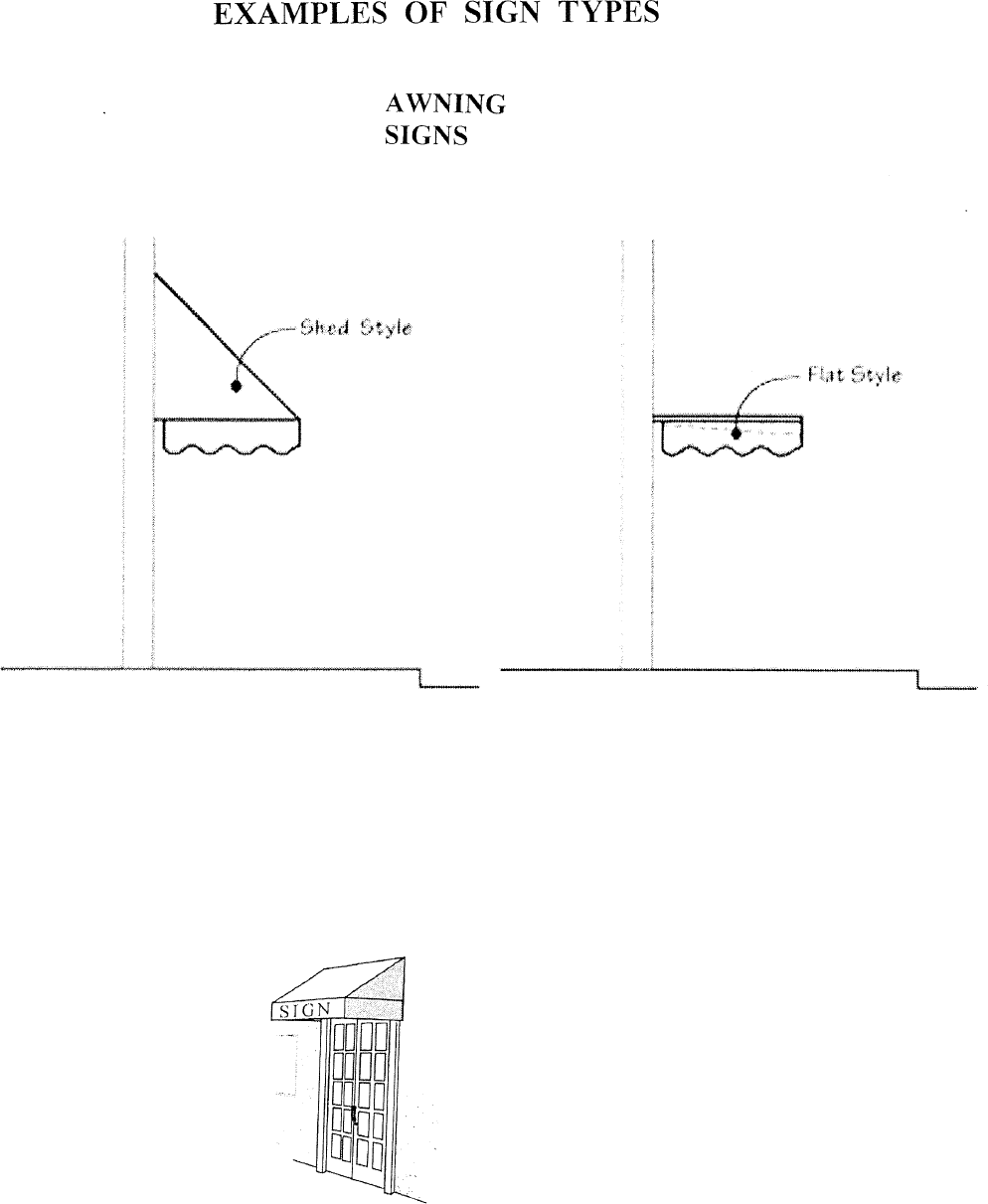
Permitted Signs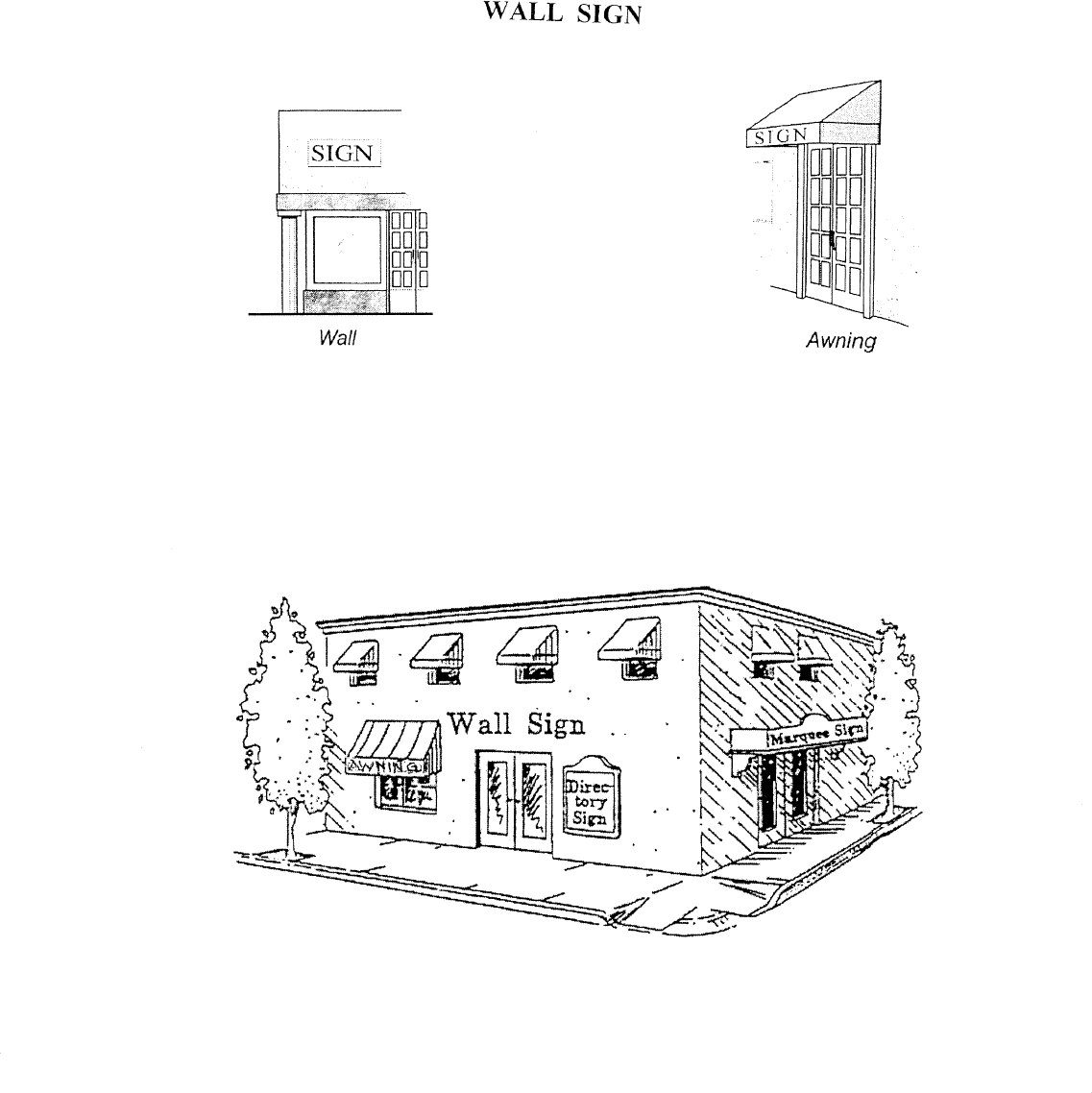
Permitted Signs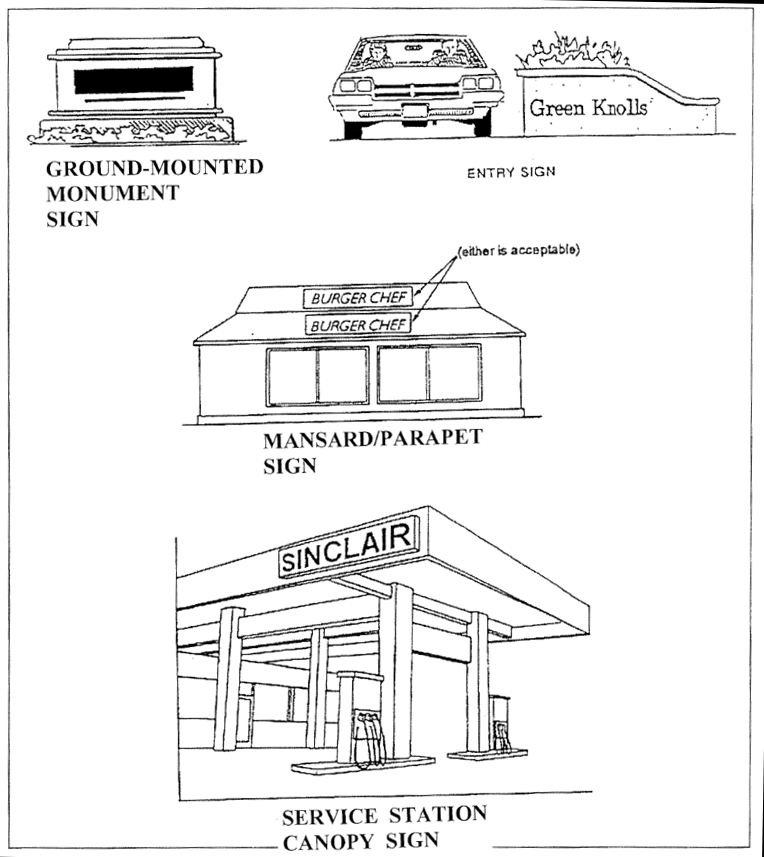
Permitted Signs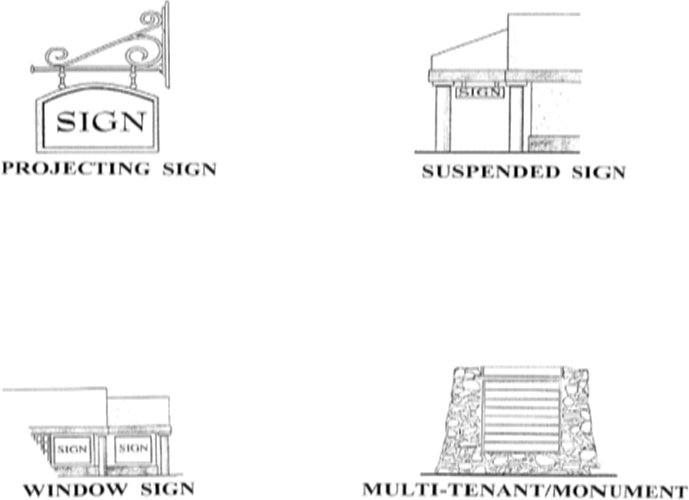
Permitted Signs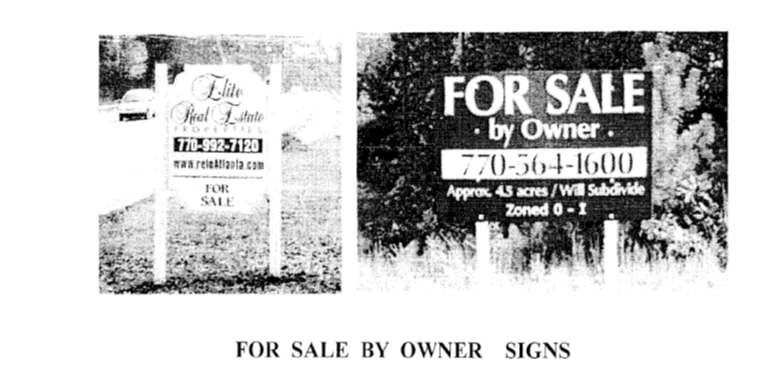
Prohibited Signs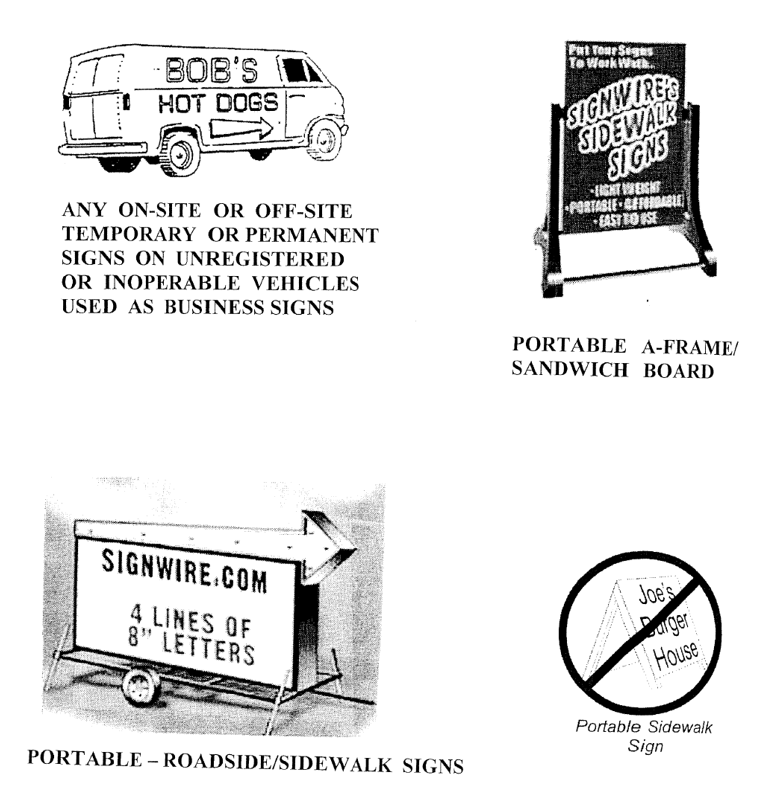

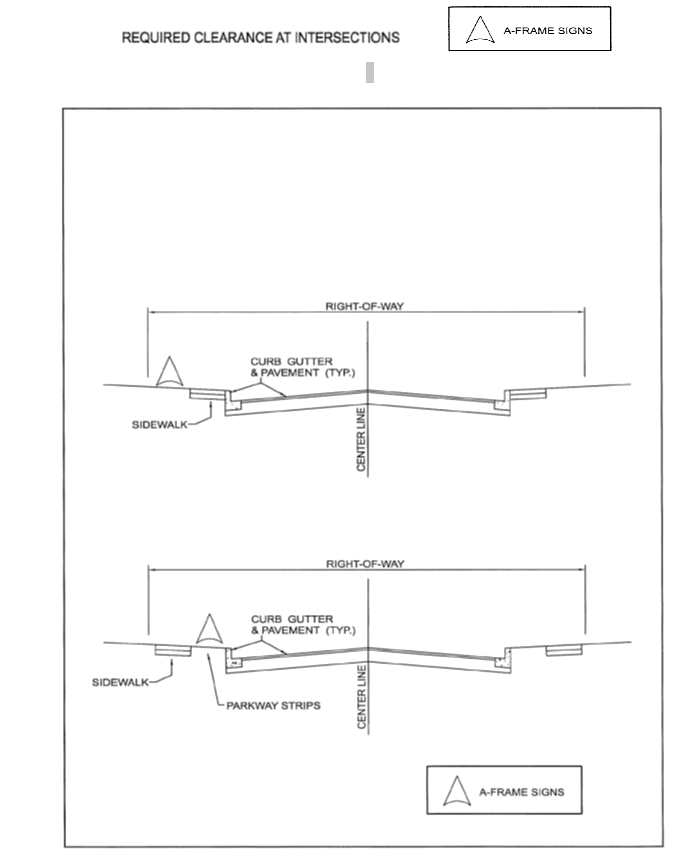
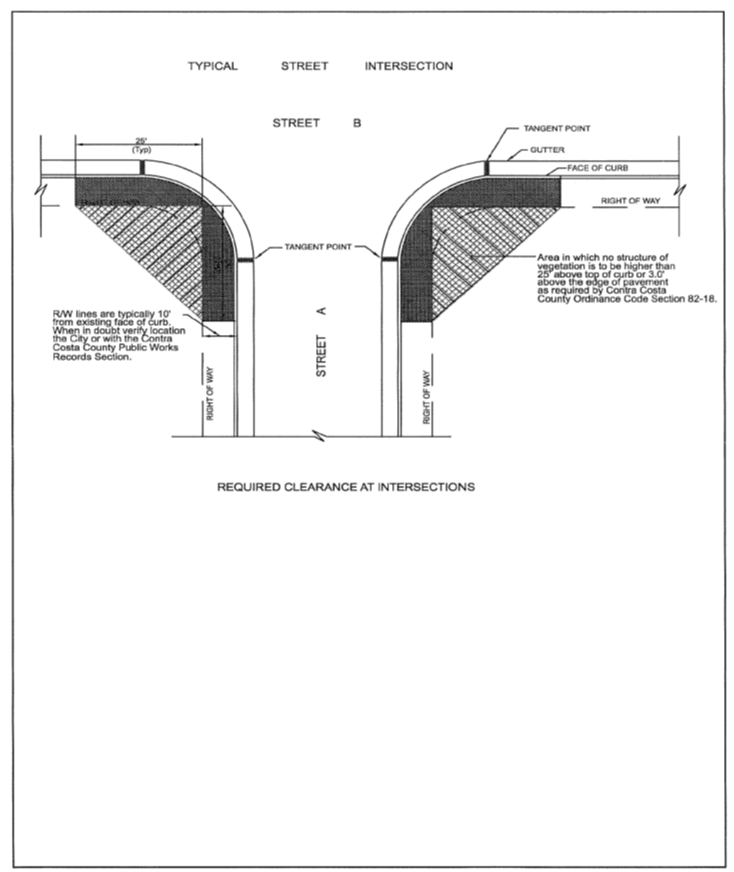
[Ord. 527 § 1, 2020; Ord. 515 § 2, 2018; ZO § 34.800.]


